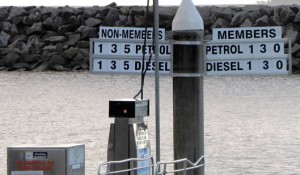Over my career there have been multiple instances where marina owners have viewed adding a fueling facility to their marina with optimism. I don’t believe the majority of owners feel this way, but for those that do, I’d like to explore this topic.
How Much Fuel?
 I’ve wondered how marina owners go about picking the size of the fuel tank they want installed and how many pumps they need. Sometimes it’s easy… you have a small marina with few amenities, so you go with a single tank that can be filled by a single delivery truck. For instance, in Nassau County, New York (and other counties too), a fuel truck transports 3,000 gallons. Regulations require that a fuel tank be filled no more than 90 percent full (otherwise the high level alarm goes off), so picking a fuel tank that is 3,000 gallons means that the tank can be fueled in a single trip. A 4,000 or 5,000 gallon tank requires more than one truck. Of course if fuel were ordered such that the tank did not get low enough to require two trips, this tank size would be fine. It becomes more of a management task than anything. If the marina is small enough for a single tank in the 5,000 gallon range, I’d expect the volume of gas sales to be such that refueling is not so time sensitive that more than a single truck would be required at any time, so perhaps this is a moot issue.
I’ve wondered how marina owners go about picking the size of the fuel tank they want installed and how many pumps they need. Sometimes it’s easy… you have a small marina with few amenities, so you go with a single tank that can be filled by a single delivery truck. For instance, in Nassau County, New York (and other counties too), a fuel truck transports 3,000 gallons. Regulations require that a fuel tank be filled no more than 90 percent full (otherwise the high level alarm goes off), so picking a fuel tank that is 3,000 gallons means that the tank can be fueled in a single trip. A 4,000 or 5,000 gallon tank requires more than one truck. Of course if fuel were ordered such that the tank did not get low enough to require two trips, this tank size would be fine. It becomes more of a management task than anything. If the marina is small enough for a single tank in the 5,000 gallon range, I’d expect the volume of gas sales to be such that refueling is not so time sensitive that more than a single truck would be required at any time, so perhaps this is a moot issue.
Another part of coming up with the size of the fuel tank involves the demand estimate. Determining how much fuel a marina will sell is usually more art than science. If the marina owner is lucky enough to have had a fueling facility in place at the marina at one time, he/she may have records about fuel sales volumes. This may be useful if it is relatively recent. Better yet, patterns in fuel consumption by week or weekend is especially useful for planning the next fuel drop.
Another component of determining the fuel tank size is how the fuel revenue is reported and how much detail is present. If, say, a marina sold $100,000 worth of fuel without knowing the average price of fuel or the price range during the season, this number by itself means nothing; the bottom line is that its the number of gallons that were sold that is relevant. Unfortunately, it’s common for marina owners to not get this information from prior owners when a fueling facility was in place and was removed many years ago.
So how do I estimate prospective fueling facility volume? That’s a long topic and one worthy of its own blog post series.
Is It Worth the Effort?
Like most things in business, spending the money has to have a return on investment. It becomes dicey for a marina because the net profit of the fuel is a fraction of the gross revenue, yet having a fuel facility may mean higher slip rentals, lower vacancies, and more patronage to amenities like a restaurant. A cost-benefit analysis is worth doing. When you add up the net profit in each of these areas (note the word “net” as compared to “gross”) and compare it to the cost of adding a fueling facility (including all hard and soft costs), is the net present value positive? In other words is it profitable to do so? If you’re uncomfortable with estimating these numbers yet still need to know (as in the case of obtaining lender financing that will include the cost of adding a fueling facility), hire someone who can calculate the numbers. Have them show you that the decision is “go” or “no go”.
The Right Way to Do It
I doubt any marina owner has the time or desire to fill out government forms for adding a fueling facility to a marina. So if they want to add fuel to their marina typically what they do is contact an engineering firm to prepare a cost estimate. Hopefully not just any engineering firm but one with an environmental background. In many cases the engineering firm will do the installation and act as the contractor; in other cases, they will contract out the job.
The engineering firm inquires into what the owner wants and where in the marina it will be located then prepares an estimate. So let’s say the owner gives it his/her stamp of approval. Although the engineering firm may have the experience, they may not have the background or desire to work the “politics” of obtaining all governmental approvals or submitting the forms to all the involved agencies. It’s not that they don’t know how to do it, it’s just that few firms do this often enough to have the process down to a science. If one approval is missing and the job breaks ground, that’s a big problem. The answer for many of these firms is to hire a contractor to obtain all approvals. This also puts a wall between the approval and installation functions, reducing the firm’s liability. Do what you do best.
Governmental Approvals
As you might guess, obtaining all the permits and approvals necessary to install fuel tanks, fuel lines, one or more pumps, etc. varies by state. Some states make it almost impossible. Others don’t mind. The main approvals that must happen belong to the county or local Fire Marshall and the Building Department. Generally beyond that, the State Department of the Environment (or whatever particular jargon a state uses to describe this agency) will have some say in the process. Beyond this, it‚ varies state by state. To my knowledge the Federal Government is not involved… or at the very least I’ve not found an instance where they’ve had to sign off on anything.
This is where having a contractor that is experienced in filing the correct paperwork in a timely manner is important. Their job is to overcome objections if there are any. How much time it takes can vary from a couple of months to over a year depending on how many government agencies are involved and their inclination for allowing additional marina fueling facilities.
The Shortcut?
Some marina owners that are optimistic about having a fueling facility installed have relied upon the concept of grandfathering. Typically there was once a fuel facility at the marina‚ yet a prior owner had it removed. Because is was there at one time, it should be easy to get one in, right? In some jurisdictions, the answer is a definite yes. I’m currently appraising a marina in New York where having had a fueling facility in place a couple of years ago made it marginally easier to get all permits in place. I say marginally because the cost of permits and consultants is the same regardless of whether the marina had a fueling facility in place at one time or is putting in its first facility.
In other jurisdictions I have been involved in, a past history of a fueling facility means nothing. If it goes beyond a certain date it is no longer grandfathered whereas in other jurisdictions, it would still be grandfathered. In some states, even though grandfathering may be in place, environmental regulations make it so onerous, time consuming, and expensive that they serve as a deterrent. There is no single answer to this issue that applies everywhere. Again, this is where the permit contractor comes in.
Conclusions
Adding a fueling facility to a marina is highly speculative. There are a great many pieces that must sequentially fall in place for it to happen. Depending on the jurisdiction, there may be more pieces to the puzzle or less. If you are a marina owner considering adding a fueling facility, you may have to spend thousands of dollars just to find out if there is a chance it can be approved by all agencies involved. Even then, you’ll want to know what the odds are and the costs of doing so before proceeding. The bottom line, as always, is to do the math.

